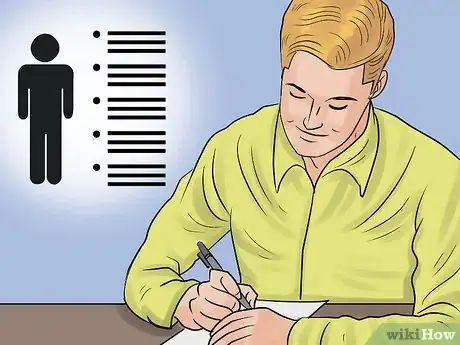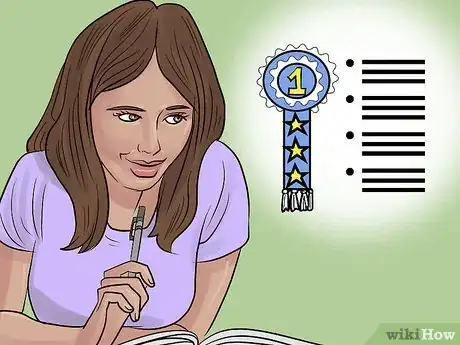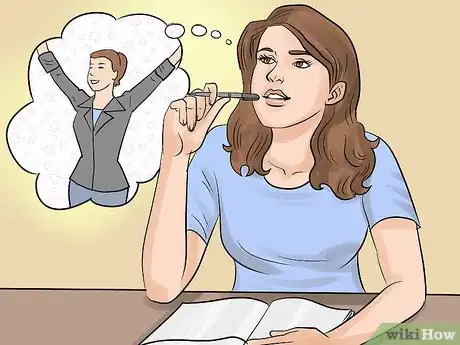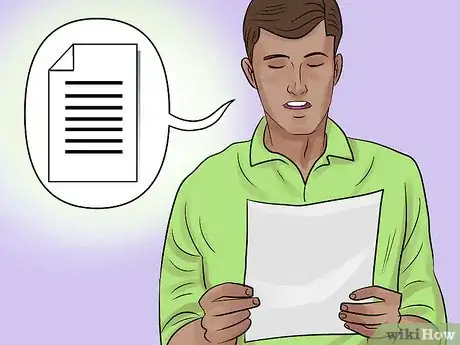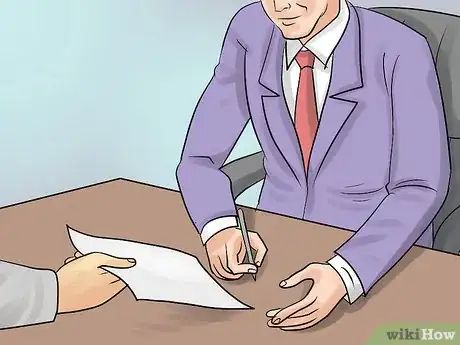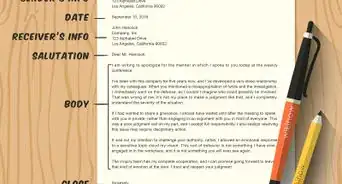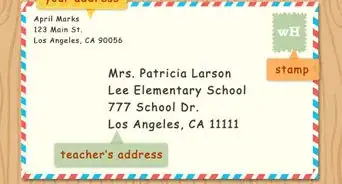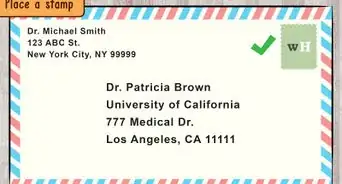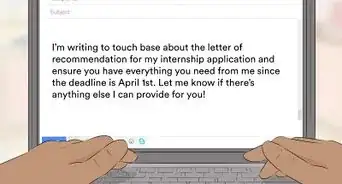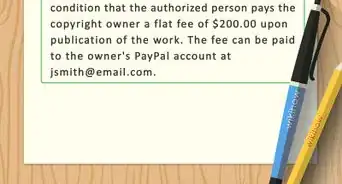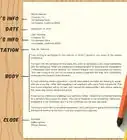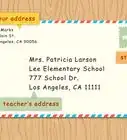This article was co-authored by Shannon O'Brien, MA, EdM. Shannon O'Brien is the Founder and Principal Advisor of Whole U. (a career and life strategy consultancy based in Boston, MA). Through advising, workshops and e-learning Whole U. empowers people to pursue their life's work and live a balanced, purposeful life. Shannon has been ranked as the #1 Career Coach and #1 Life Coach in Boston, MA by Yelp reviewers. She has been featured on Boston.com, Boldfacers, and the UR Business Network. She received a Master's of Technology, Innovation, & Education from Harvard University.
This article has been viewed 66,843 times.
You may need a letter of recommendation for a job prospect or as part of your application for school. It is pretty common practice for your recommender to ask you to write the letter yourself, as you know your skills and attributes better than they do and can characterize yourself well in words. You may struggle with writing your own letter of recommendation, especially if you aren’t keen on bragging about yourself to others. To write the letter, start by outlining the letter and writing the letter with the outline in mind. Then, make sure you revise and polish the letter so it is ready for your recommender to sign.
Steps
Outlining the Letter
-
1Match your skills to the job or application's description. Think about the types of skills and attributes required in the job description or as part of being a good student at a university. Make a list of skills and attributes that you possess that connect to the position.[1] Focus on specific skills and attributes you have that feel relevant and important after looking at the job or application's description.[2]
- For example, if you are applying for a position at a non-profit organization, you may list skills and attributes like, “a good multi-tasker, able to be client facing, a confident public speaker, a good communicator, and a strong writer.”
- If you are applying for school, you may list skills and attributes like, “able to meet deadlines, an active member of the community, a strong writer and reader, and a good student with a high GPA.”
-
2Brainstorm 2-3 top accomplishments that you can discuss later on. You should also focus on two to three accomplishments that relate to the position you are applying for with the letter. This could be a student award you won or a job accomplishment that you are proud of. Pick at least one accomplishment that relates to your experience with the recommender. This way, you can discuss it in your letter from their perspective and use it as evidence of your qualifications.[3]
- For example, if you are writing the letter on behalf of your professor, you may list an A+ paper you wrote in their class or a project that you completed in their course.
- If you are writing the letter on behalf of your employer, you may list a sales target you hit as their employee or a key client that you landed for the recommender’s company.
Advertisement -
3Show don't tell. Think about one scenario or situation illustrates your strengths as an applicant. Make sure the scenario involves the person “writing” the letter, such as your professor or your employee. You can then use this scenarios or situation as an example of your qualifications as an applicant.
- The scenario should be short and to the point. You should be able to summarize it in one to two sentences.
- For example, you may focus on a scenario where you went above and beyond expectations for an assignment, resulting in a high grade. Or you may choose a situation where you won over a client by doing detailed research for a contract.
Writing the Letter
-
1Start with a formal address. Letters of recommendation are official documents and should start with a formal address, such as “Dear Mr./Mrs./Ms. [Last Name].” If possible, the letter should be written on organizational letterhead. Your recommender may need to print the letter out for you on official letterhead once the letter is complete.[4]
- Most letters of recommendation are no longer than one page, with one paragraph for an opening, two body paragraphs, and a short ending paragraph.[5]
- The paragraphs in the letter should be flush left and written with 11 point or 12 point font.
-
2State the recommender’s relationship to you. Begin the letter by stating the purpose of the letter and how the recommender knows you. Stating the recommender’s relationship to you up front will put the letter in context and show the reader that the recommender is speaking from a place of knowledge and experience.[6]
- For example, you may begin with, “It is my pleasure to recommend [Your Name] for admission to your graduate program. I have known [Your Name] for nearly three years, during which time she was my undergraduate student as well as my teaching assistant for a leading social change course.”
- Or, if you are writing the letter for a job application, you may start with, “It’s my absolute pleasure to recommend [Your Name] for [position] with [Company]. [Your Name] and I worked together at [Company] for [length of time]. I thoroughly enjoyed working with [Your Name] and viewed [him/her] as a valuable employee in my team.”
-
3Focus on skills and attributes that relate to the position. Next, make sure you include a paragraph that focuses on your skills and attributes, as well as how they relate to the position you are applying for. Include skills or traits that also show your relationship to the recommender. Use one to two examples to support these skills and attributes.[7]
- For example, you may write, “[His/her] knowledge of social justice issues and expertise in leading social change was a huge advantage during the class. [Your Name] put this skillset to work in order to assist students with their questions and guide class discussion. [He/she] was an invaluable resource for students during the class.”
-
4Include one to two accomplishments. Pick one to two accomplishments that speak to the position or illustrate skills that are important for the job. Choose accomplishments that involve the recommender so it feel relevant to them. This will also give the letter more credibility, as you want to include accomplishments that the recommender can speak to or vouch for.
- For example, you may include an accomplishment like assisting a student when you were a teaching assistant for the recommender’s class. Or you may include an accomplishment like working with a team of coworkers to get a project done that was overseen by the recommender.
- You may write, “[His/her] ability to assist a student who needed guidance and direction in the class was a joy to witness. [He/she] impressed me with their tact, professionalism, and ability to communicate with students on a peer to peer level.”
-
5Reinforce your recommendation. In the second body paragraph, make sure you reinforce that you recommend the applicant whole heartedly. Include one to two sentences that highlight the recommendation as well as a brief summary why. This will underscore the recommender’s high opinion of you and make it clear that you are a strong applicant.
- For example, you may write, “I confidently recommend [Your Name] to join your team at [Company]” or “Without a doubt, I confidently recommend [Your Name] as a student in your graduate program.”
-
6End with contact information and a formal sign off. Finish the letter by including contact information for the recommender. This could be an email address or a phone number. Then, include a formal sign off like “Best wishes,” “Sincerely,” or “Best,” and the recommender’s name, typed. Leave a blank space between the sign off and the recommender’s name so they can sign the letter.
- For example, you may write, “Please feel free to contact me at [contact information] in the event you would like to discuss [Your Name]’s qualifications and skills in more detail. I would be happy to provide more information on my recommendation.”
Polishing the Letter
-
1Read the letter out loud. Once you have completed a draft of the letter, sit down and read it out loud to yourself. Listen to how each sentence flows and determine if each sentence makes sense. Revise any confusing words and clarify any sentences that are too long or convoluted. Check that you use language that is consistent and professional throughout the letter.
- You may also find it helpful to read the letter out loud to someone else, such as a peer or a coworker. Ask them for feedback on the letter to make sure it comes across as professional and effective.
-
2Check that the tone and voice matches the recommender. You are writing the letter from the perspective of the recommender, so the tone and voice in the letter should match their tone and voice in class or at work. Make sure the letter has a tone of professionalism and eloquence. Read over the letter to ensure the language use and word choice follow that of the recommender.
- When in doubt, keep the sentences simple, polished, and to the point.[8] Trying to include too many obscure references or words will only make the letter more confusing and difficult to read.
-
3Proofread the letter for grammatical errors. Make sure there are no spelling, grammar, or punctuation errors in the letter. Having even a single spelling error will make the reader suspicious that the recommender wrote the letter or that the letter has been polished so it is at its best.
- Run the letter through spell check on your computer and read it backwards to check that each word is correct.
-
4Get the letter signed by the recommender. When you feel the letter of recommendation is the best it can be, submit it to the recommender to be signed. The recommender may review the letter and confirm it is to their standard before they sign it. Or they may revise the letter as they see fit and give it back to you signed.
- Make sure you submit the letter to the recommender a few days or weeks before the deadline for your application so they have enough time to read the letter over and sign it.
Community Q&A
-
QuestionWhy is this written in third person if it's supposed to be about myself?
 Community AnswerIt's in third person because the person who will be giving your recommendation letter will use this a guide. Also, even if you were the one to send this recommendation yourself, you still need to write it in third person because it's supposed to be from an objective point of view.
Community AnswerIt's in third person because the person who will be giving your recommendation letter will use this a guide. Also, even if you were the one to send this recommendation yourself, you still need to write it in third person because it's supposed to be from an objective point of view.
References
- ↑ Shannon O'Brien, MA, EdM. Life & Career Coach. Expert Interview. 24 September 2021.
- ↑ http://www.vault.com/blog/job-search/how-to-write-your-own-recommendation-letter/
- ↑ http://www.vault.com/blog/job-search/how-to-write-your-own-recommendation-letter/
- ↑ https://www.forbes.com/sites/dailymuse/2016/05/06/heres-a-template-to-write-a-perfect-and-personalized-letter-of-recommendation/#196d10e76a32
- ↑ Shannon O'Brien, MA, EdM. Life & Career Coach. Expert Interview. 24 September 2021.
- ↑ http://www.vault.com/blog/job-search/how-to-write-your-own-recommendation-letter/
- ↑ Shannon O'Brien, MA, EdM. Life & Career Coach. Expert Interview. 24 September 2021.
- ↑ Shannon O'Brien, MA, EdM. Life & Career Coach. Expert Interview. 24 September 2021.
